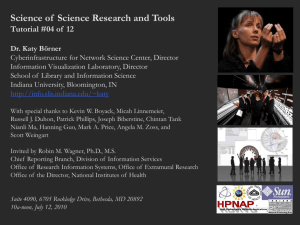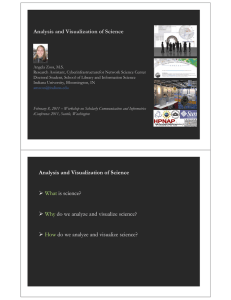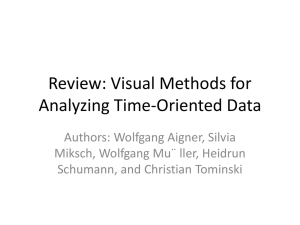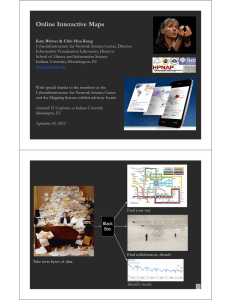Science of Science Research and Tools Tutorial #04 of 12
advertisement
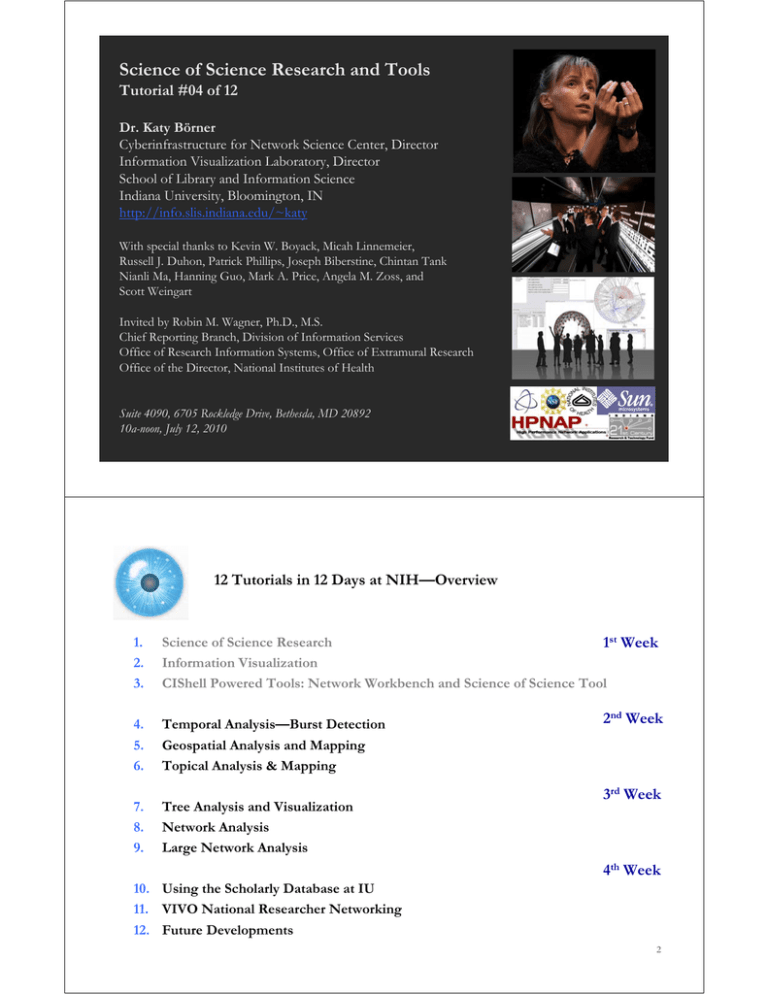
Science of Science Research and Tools Tutorial #04 of 12 Dr. Katy Börner Cyberinfrastructure for Network Science Center, Director Information Visualization Laboratory, Director School of Library and Information Science Indiana University, Bloomington, IN http://info.slis.indiana.edu/~katy With special thanks to Kevin W. Boyack, Micah Linnemeier, Russell J. Duhon, Patrick Phillips, Joseph Biberstine, Chintan Tank Nianli Ma, Hanning Guo, Mark A. Price, Angela M. Zoss, and Scott Weingart Invited by Robin M. Wagner, Ph.D., M.S. Chief Reporting Branch, Division of Information Services Office of Research Information Systems, Office of Extramural Research Office of the Director, National Institutes of Health Suite 4090, 6705 Rockledge Drive, Bethesda, MD 20892 10a-noon, July 12, 2010 12 Tutorials in 12 Days at NIH—Overview 1. 2. 3. Science of Science Research 1st Week Information Visualization CIShell Powered Tools: Network Workbench and Science of Science Tool 4. 5. 6. Temporal Analysis—Burst Detection Geospatial Analysis and Mapping Topical Analysis & Mapping 7. 8. 9. Tree Analysis and Visualization Network Analysis Large Network Analysis 2nd Week 3rd Week 4th Week 10. Using the Scholarly Database at IU 11. VIVO National Researcher Networking 12. Future Developments 2 12 Tutorials in 12 Days at NIH—Overview [#04] Temporal Analysis—Burst Detection Science of Science (Sci2) Tool (left over from Tutorial #3) Temporal Analysis Overview Designing Effective Charts Sci2-Horizontal Bar Charts Sci2-Burst Analysis and Visualization Outlook Exercise: Identify Promising Temporal Analyses of NIH Data Recommended Reading Information Visualization Cyberinfrastructure > Learning Modules > Visualizing Time Series Data, http://iv.slis.indiana.edu/lm/lm-time-series.html NWB Team (2009) Network Workbench Tool, User Manual 1.0.0, http://nwb.slis.indiana.edu/Docs/NWBTool-Manual.pdf Scott Weingart, Hanning Guo, Katy Borner, Kevin W. Boyack, Micah W. Linnemeier, Russell J. Duhon, Patrick A. Phillips, Chintan Tank, and Joseph Biberstine (2010) Science of Science (Sci2) Tool User Manual. Cyberinfrastructure for Network Science Center, School of Library and Information Science, Indiana University, Bloomington. http://sci.slis.indiana.edu/registration/docs/Sci2_Tutorial.pdf 3 12 Tutorials in 12 Days at NIH—Overview [#05] Geospatial Analysis and Mapping General Overview Designing Effective Geomaps Sci2-Geomaps With Circle and Colored Region Annotation Sci2-Animations Geographic Information Systems (GIS) Outlook Exercise: Identify Promising Geospatial Analyses of NIH Data Recommended Reading NWB Team (2009) Network Workbench Tool, User Manual 1.0.0, http://nwb.slis.indiana.edu/Docs/NWBTool-Manual.pdf Scott Weingart, Hanning Guo, Katy Borner, Kevin W. Boyack, Micah W. Linnemeier, Russell J. Duhon, Patrick A. Phillips, Chintan Tank, and Joseph Biberstine (2010) Science of Science (Sci2) Tool User Manual. Cyberinfrastructure for Network Science Center, School of Library and Information Science, Indiana University, Bloomington. http://sci.slis.indiana.edu/registration/docs/Sci2_Tutorial.pdf 4 12 Tutorials in 12 Days at NIH—Overview [#06] Topical Analysis & Mapping General Overview Designing Effective Topic Maps Sci2-Term Co-Occurrence Analysis and Networks Sci2-Science Maps With Circle Annotation Sci2-Animations Outlook Exercise: Identify Promising Geospatial Analyses of NIH Data Recommended Reading NWB Team (2009) Network Workbench Tool, User Manual 1.0.0, http://nwb.slis.indiana.edu/Docs/NWBTool-Manual.pdf Scott Weingart, Hanning Guo, Katy Borner, Kevin W. Boyack, Micah W. Linnemeier, Russell J. Duhon, Patrick A. Phillips, Chintan Tank, and Joseph Biberstine (2010) Science of Science (Sci2) Tool User Manual. Cyberinfrastructure for Network Science Center, School of Library and Information Science, Indiana University, Bloomington. http://sci.slis.indiana.edu/registration/docs/Sci2_Tutorial.pdf 5 [#04] Temporal Analysis—Burst Detection Science of Science (Sci2) Tool (left over from Tutorial #3) Temporal Analysis Overview Designing Effective Charts Sci2-Horizontal Bar Charts Sci2-Burst Analysis and Visualization Outlook Exercise: Identify Promising Temporal Analyses of NIH Data 6 Science of Science (Sci2) Tool http://sci.slis.indiana.edu Explicitly designed for SoS research and practice, well documented, easy to use. Empowers many to run common studies while making it easy for exports to execute novel research. Advanced algorithms, effective visualizations, and many (standard) workflows. Supports detailed documentation and replication of studies. Is open source—anybody can review and extend the code, or use it for commercial purposes. 77 Sci2 Tool – “Open Code for S&T Assessment” OSGi/CIShell powered tool with NWB plugins and many new scientometrics and visualizations plugins. Sci Maps GUESS Network Vis Horizontal Time Graphs Börner, Katy, Huang, Weixia (Bonnie), Linnemeier, Micah, Duhon, Russell Jackson, Phillips, Patrick, Ma, Nianli, Zoss, Angela, Guo, Hanning & Price, Mark. (2009). Rete-Netzwerk-Red: Analyzing and Visualizing Scholarly Networks Using the Scholarly Database and the Network Workbench Tool. Proceedings of ISSI 2009: 12th International Conference on Scientometrics and Informetrics, Rio de Janeiro, Brazil, July 14-17 . Vol. 2, pp. 619-630. Sci2 Tool Geo Maps Circular Hierarchy Sci2 Tool: Algorithms See https://nwb.slis.indiana.edu/community Preprocessing Modeling Extract Top N% Records Extract Top N Records Normalize Text Slice Table by Line --------------------------------------------Extract Top Nodes Extract Nodes Above or Below Value Delete Isolates --------------------------------------------Extract top Edges Extract Edges Above or Below Value Remove Self Loops Trim by Degree MST-Pathfinder Network Scaling Fast Pathfinder Network Scaling --------------------------------------------Snowball Sampling (in nodes) Node Sampling Edge Sampling --------------------------------------------Symmetrize Dichotomize Multipartite Joining --------------------------------------------Geocoder --------------------------------------------Extract ZIP Code Random Graph Watts-Strogatz Small World Barabási-Albert Scale-Free TARL Analysis Network Analysis Toolkit (NAT) Unweighted & Undirected Node Degree Degree Distribution --------------------------------------------K-Nearest Neighbor (Java) Watts-Strogatz Clustering Coefficient Watts Strogatz Clustering Coefficient over K --------------------------------------------Diameter Average Shortest Path Shortest Path Distribution Node Betweenness Centrality --------------------------------------------Weak Component Clustering Global Connected Components --------------------------------------------Extract K-Core Annotate K-Coreness --------------------------------------------HITS Weighted & Undirected Clustering Coefficient Nearest Neighbor Degree Strength vs Degree Degree & Strength Average Weight vs End-point Degree Strength Distribution Weight Distribution Randomize Weights --------------------------------------------Blondel Community Detection --------------------------------------------HITS Unweighted & Directed Node Indegree Node Outdegree Indegree Distribution Outdegree Distribution --------------------------------------------K-Nearest Neighbor Single Node in-Out Degree Correlations --------------------------------------------Dyad Reciprocity Arc Reciprocity Adjacency Transitivity --------------------------------------------Weak Component Clustering Strong Component Clustering --------------------------------------------10 Sci2 Tool: Algorithms cont. See https://nwb.slis.indiana.edu/community -------------------------------Extract K-Core Annotate K-Coreness -------------------------------HITS PageRank Weighted & Directed HITS Weighted PageRank Textual Burst Detection NEW: Database support for ISI and NSF data. Visualization Scientometrics GnuPlot GUESS Image Viewer --------------------------------------------Radial Tree/Graph (prefuse alpha) Radial Tree/Graph with Annotation (prefuse beta) Tree View (prefuse beta) Tree Map (prefuse beta) Force Directed with Annotation (prefuse beta) Fruchterman-Reingold with Annotation (prefuse beta) --------------------------------------------DrL (VxOrd) Specified (prefuse beta) --------------------------------------------Horizontal Line Graph Circular Hierarchy Geo Map (Circle Annotation Style) Geo Map (Colored-Region Annotation Style) *Science Map (Circle Annotation) Remove ISI Duplicate Records Remove Rows with Multitudinous Fields Detect Duplicate Nodes Update Network by Merging Nodes --------------------------------------------Extract Directed Network Extract Paper Citation Network Extract Author Paper Network --------------------------------------------Extract Co-Occurrence Network Extract Word Co-Occurrence Network Extract Co-Author Network Extract Reference Co-Occurrence (Bibliographic Coupling) Network --------------------------------------------Extract Document Co-Citation Network * Requires permission from UCSD All four+ save into Postscript files. Automatic legends. See Sci2 Manual, Section 3.1 for details. http://sci.slis.indiana.edu/registra tion/docs/Sci2_Tutorial.pdf 11 Sci2 Tool: Download, Install, and Run Sci2 Tool Alpha 3 (March 2010) Can be freely downloaded for all major operating systems from http://sci.slis.indiana.edu/sci2 Select your operating system from the pull down menu and download. Unpack into a /sci2 directory. Run /sci2/sci2.exe Session log files are stored in ‘*yournwbdirectory*/logs’ directory. Cite as Sci2 Team. (2009). Science of Science (Sci2) Tool. Indiana University and SciTech Strategies, http://sci.slis.indiana.edu. The file was also made available as sci2-N-1.0.0.201003270106NGTwin32.win32.x86.zip on the computers in the tutorial room. 12 Sci2 Tool supports usage of databases for specific file formats. Menu is organized by types of analysis. [#04] Temporal Analysis—Burst Detection Science of Science (Sci2) Tool (left over from Tutorial #3) Temporal Analysis Overview Designing Effective Charts Sci2-Horizontal Bar Charts Sci2-Burst Analysis and Visualization Outlook Exercise: Identify Promising Temporal Analyses of NIH Data 15 Time Series Analysis and Visualization Main Goals: Identifying the nature of the phenomenon represented by the sequence of observations. Forecasting, i.e., predicting future values of the time series variable(s). Identifying Patterns in Time Series Data Systematic pattern and random noise: Frequently, some form of filtering is applied to reduce noise in order to make patterns more salient. Two general aspects of time series patterns: Trend (e.g., increase in spam email) and seasonality (e.g., emails received at night/day). Trend Analysis: Smoothing (e.g., averaging using a smoothing window of a certain width) and curve approximation/fitting. Burst Analysis Etc. Information Visualization Course, Katy Börner, Indiana University Balance of Trade Chart by Playfair in 1786 The area between two time-series curves was emphasized to show the difference between them, representing the balance of trade. Interactive Baby Name Wizard http://babynamewizard.com/namevoyager/lnv0105.html Animation of Tectonic Movement www.scotese.com/jurassic.htm Information Visualization Course, Katy Börner, Indiana University www.scotese.com/jurassic.htm Information Visualization Course, Katy Börner, Indiana University www.scotese.com/jurassic.htm Information Visualization Course, Katy Börner, Indiana University Continental Drift Animation http://www.ucmp.berkeley.edu/geology/anim1.html Gapminder presentation by Hans Rosling http://www.ucmp.berkeley.edu/geology/anim1.html http://www.ted.com/index.php/talks/hans_rosling_shows_the_best_stats_you_ve_ever_seen.html [#04] Temporal Analysis—Burst Detection Science of Science (Sci2) Tool (left over from Tutorial #3) Temporal Analysis Overview Designing Effective Charts Sci2-Horizontal Bar Charts Sci2-Burst Analysis and Visualization Outlook Exercise: Identify Promising Temporal Analyses of NIH Data 24 Designing Effective Charts— Please consult Wong’s recent book In this book, you will learn: to choose the best chart that fits your data; the most effective way to communicate with decision makers when you have five minutes of their time; how to chart currency fluctuations that affect global business; how to use color effectively; how to make a graphic “colorful” even if only black and white are available. The book is organized in a series of mini-workshops backed up with illustrated examples, so not only will you learn what works and what doesn’t but also you can see the dos and don’ts for yourself. This is an invaluable reference work for students and professional in all fields. 25 [#04] Temporal Analysis—Burst Detection Science of Science (Sci2) Tool (left over from Tutorial #3) Temporal Analysis Overview Designing Effective Charts Sci2-Horizontal Bar Charts – Using NIH Data Sci2-Burst Analysis and Visualization Outlook Exercise: Identify Promising Temporal Analyses of NIH Data 26 RePORTER Datasets QVR Query for MIDAS* Grants Select awarded grants in the Primary Search section Enter MIDAS RFA numbers in the application ID section Execute search Download hit list * NIGMS Modeling of Infectious Disease Agent Study Slide provided by James Onken 27 QVR Query for MIDAS Grants (Cont’d) Select data elements Export to Excel Slide provided by James Onken 28 SPIRES Query for MIDAS Publications Conduct Publication Search Select custom download Clear your IC from selection box (if necessary) Open Project Detail Search Screen Slide provided by James Onken 29 SPIRES Query for MIDAS Publications (cont’d) Enter MIDAS RFA Number Search Publications Select data elements Download Excel file Repeat process for GM05‐011 Slide provided by James Onken 30 RePORTER Data Preparation Open NIH*.xls in MS Excel. It contains two worksheets: ‘Grants’ and ‘Publications’. Save both worksheets separately as CSV (comma delimited) files, e.g., Grants.csv Publications.csv Get data files from Memory Stick 31 RePORTER Data Format: Grants Data Fields: Application ID Full Project Number (including subproject ID) Project ID Type Activity Administering IC Serial Number Support Year Suffix Subproject ID Study Section Study Section Name RFA/PA Number Project/Subproject Title Funding IC(s) FY Total Costs Fiscal Year of Funding Budget start date Budget end date Project start date Project end date Organization Name Organization Department Organization City Organization State Country Name Organization FIPS Country Code Congressional District DUNS Number Contact PI ID PI(s) Name IC Name Abstract Public health relevance Project term descriptions NIH reporting categories Unique IDs are bolded Temporal Analysis Geospatial Analysis (also zip code Topical Analysis (see also Title, RCDC categories) Network Analysis Project Attributes (ideally also award total costs) 32 RePORTER Data Format: Publications Data Fields: Application ID Project ID PubMed ID Publication Title Authors ISSN Journal Title Abbr Journal Volume Journal Issue Page Number Publish Date Mesh Terms Unique IDs are bolded Temporal Analysis Geospatial Analysis (also zip code Topical Analysis (see also Title, RCDC categories) Network Analysis Project Attributes (Times Cited via Web of Science) 33 RePORTER Data Format: Grants and Publications CTSA Project RR024126 has 4 Grant records and 7 Publication records 4 7 34 NIH CTSA Grants: Over Time Grant records with identical title were aggregated. Project/Subproject Title Clinical and Translational Science Award Clinical and Translational Science Institute UC Davis CTSA Duke CTSI ` # Records 33 22 20 19 See NIH-CTSA-Grants-Aggregated4Temporal.csv Area size equals numerical value, e.g., award amount. Text, e.g., title Start date End date Area size equals numerical value, e.g., award amount. NIH CTSA Grants: Over Time Text, e.g., title Start date For a summary of the grants themselves, with a visual representation of their award amount, load the NSF csv file, select it in the Data Manager, and run ‘Visualization > Temporal > Horizontal Bar Graph’, entering the following parameters: The generated postscript file can be saved and viewed using Adobe Distiller or GhostViewer (see Section 2.4 Saving Visualizations for Publication). End date [#04] Temporal Analysis—Burst Detection Science of Science (Sci2) Tool (left over from Tutorial #3) Temporal Analysis Overview Designing Effective Charts Sci2-Horizontal Bar Charts – Using NSF Data – Topic Area Sci2-Burst Analysis and Visualization Outlook Exercise: Identify Promising Temporal Analyses of NIH Data 37 Biomedical Funding Profile of NSF (NSF Data) (Sci2 Manual, Section 5.2.4) What organizations and programs at the National Science Foundation support projects that deal with medical and health related topics? Data was downloaded from the NSF Awards Search SIRE (http://www.nsf.gov/awardsearch) on Nov 23rd, 2009, using the query “medical AND health” in the title, abstract, and awards field, with “Active awards only” checked (see section 4.2.2.1 NSF Award Search for data retrieval details). 38 Biomedical Funding Profile of NSF (NSF Data) (section 5.2.4) Using NSF Awards Search: http://www.nsf.gov/awardsearch download relevant NSF awards that have “medical” AND “health” in title, abstract, and awards. Active awards only. Number of awards: 283 awards Total awarded amount to date: $152,015,288 File is available in /sampledata/scientometrics/nsf/ MedicalAndHealth.nsf Retrieved on Oct 18, 2009 39 Biomedical Funding Profile of NSF (NSF Data) (section 5.2.4) For a summary of the grants themselves, with a visual representation of their award amount, load the NSF csv file, select it in the Data Manager, and run ‘Visualization > Temporal > Horizontal Bar Graph’, entering the following parameters: The generated postscript file can be saved and viewed using Adobe Distiller or GhostViewer (see Section 2.4 Saving Visualizations for Publication). 40 Biomedical Funding Profile of NSF (NSF Data) (section 5.2.4) How to read a Horizontal Bar Graph: Area size equals numerical value, e.g., award amount. Text, e.g., title Start date End date Top-10 grants with highest $Awarded to Date: 41 Biomedical Funding Profile of NSF (NSF Data) (section 5.2.4) Horizontal Bargraph 42 Biomedical Funding Profile of NSF (NSF Data) (section 5.2.4) Change parameter values as needed to achieve legible layout. Color code bars ti distinguish different award types. Print in large and hang on wall for very large datasets. (The one on the right has 283 records) 43 [#04] Temporal Analysis—Burst Detection Science of Science (Sci2) Tool (left over from Tutorial #3) Temporal Analysis Overview Designing Effective Charts Sci2-Horizontal Bar Charts – Using NSF Data – Comparing Individual Funding Profiles Sci2-Burst Analysis and Visualization Outlook Exercise: Identify Promising Temporal Analyses of NIH Data 44 Mapping Funding Portfolios at the Individual Level Using NSF Awards Search via http://www.nsf.gov/awardsearch Save SaveininCSV CSVformat formatasas*name*.nsf *name*.nsf NSF Awards Search Results Name Geoffrey Fox Michael McRobbie Beth Plale # Awards 27 8 10 First A. Starts Aug 1978 July 1997 Aug 2005 Total Amount to Date 12,196,260 19,611,178 7,224,522 These files are available in /sampledata/scientometrics/nsf/ Disclaimer: Only NSF funding, no funding in which they were senior personnel, only as good as NSF’s internal record keeping and unique person ID. If there are ‘collaborative’ awards then only their portion of the project (award) will be included. Comparing Funding Portfolios at the Individual Level Last Expiration date Geoffrey Fox July 10 Michael McRobbie Feb 10 Beth Plale Sept 09 [#04] Temporal Analysis—Burst Detection Science of Science (Sci2) Tool (left over from Tutorial #3) Temporal Analysis Overview Designing Effective Charts Sci2-Horizontal Bar Charts Sci2-Burst Analysis and Visualization Outlook Exercise: Identify Promising Temporal Analyses of NIH Data 48 Burst Detection in Scientometrics (ISI Data) (Sci2 Manual, Section 5.2.6) Next, we want to know what topics drive research in scientometrics research and which of these topics and author names experienced a sudden increase in usage frequency over the 31 years this dataset covers. This section demonstrates the application of burst detection described in Section 4.6.1 Burst Detection. Please see http://sci.slis.indiana.edu/registration/docs/Sci2_Tutorial.pdf, p. 74 49 [#04] Temporal Analysis—Burst Detection Science of Science (Sci2) Tool (left over from Tutorial #3) Temporal Analysis Overview Designing Effective Charts Sci2-Horizontal Bar Charts Sci2-Burst Analysis and Visualization Sci2-Animations Outlook Exercise: Identify Promising Temporal Analyses of NIH Data 50 Outlook Planned extensions of Sci2 Tool: Database support for RePORTER -> merging into ‘project buckets’, correct time/data formats for subsequent analysis, time slicing. Temporal animations, e.g., network overlays for geo maps and science maps. 51 [#04] Temporal Analysis—Burst Detection Science of Science (Sci2) Tool (left over from Tutorial #3) Temporal Analysis Overview Designing Effective Charts Sci2-Horizontal Bar Charts Sci2-Burst Analysis and Visualization Sci2-Animations Outlook Exercise: Identify Promising Temporal Analyses of NIH Data 52 Exercise Please identify a promising temporal analysis of NIH data. Document it by listing Project title User, i.e., who would be most interested in the result? Insight need addressed, i.e., what would you/user like to understand? Data used, be as specific as possible. Analysis algorithms used. Visualization generated. Please make a sketch with legend. Exercise 53 All papers, maps, cyberinfrastructures, talks, press are linked from http://cns.slis.indiana.edu 54
